If you’ve ever used a 3D printer, you’ve most likely heard about Thingiverse. It’s one of the most popular online collections of 3D printing files and maintains a highly active community. Many current users would be surprised to know it has been in operation since 2008 and was originally started by MakerBot as a companion website for their early 3D printers.
Once a niche site, Thingiverse has become the largest online repository for 3D files in the world. Currently, the site hosts over 2.5 million files with hundreds of millions of downloads. Engineers, scientists, industry leaders, designers, and teachers all use the site to save, organize, and distribute files. Novice makers find the repository appealing due to its ease of use. Even enthusiasts without a 3D printer can use the site to find the design they need, then get it printed via a 3D printing service.
Today, Thingiverse is a growing resource where designers share their work, and enthusiasts can find new files to download and print. However, the site and its community are much more than that.
In this article, we’ll take a closer look at what makes Thingiverse unique as well as the growing competition that challenges its dominance in the 3D model space.
Considerations
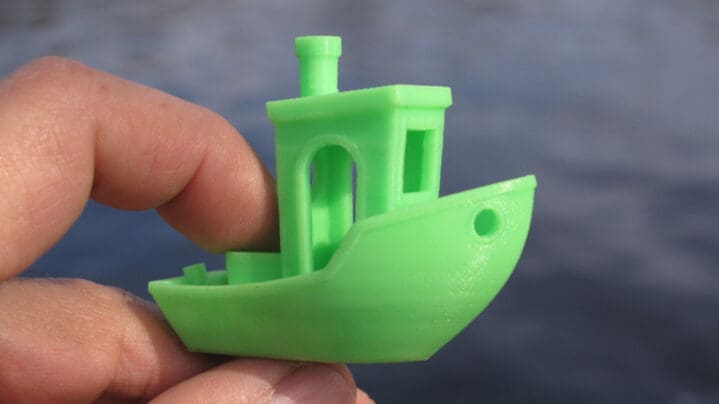
As with any repository, Thingiverse is organized into categories for different types of objects or needs. It has a clean user interface, which puts the 3D files up front and center. The moment the homepage opens, files are already there and ready for download.
Much the same could be said about other repositories, though. So, what are Thingiverse’s key characteristics that set it apart?
- Free: While most things in life aren’t free, every file on Thingiverse is. Thingiverse is about sharing, not buying. As they indicate on the site, “In the spirit of maintaining an open platform, all designs are encouraged to be licensed under a Creative Commons license, meaning that anyone can use or alter any design.” While some designs do indicate certain limitations, for the most part, everything on the site is available for personal use free of charge. For those exceptional designers with popular downloads, the site even provides a way to “tip” them for their work.
- Not a marketplace: Since monetization of file downloads isn’t its primary objective, Thingiverse has concentrated on being an open community. The focus is on discovering, creating, sharing, and remixing designs. You can easily find new creators, curated models, and fresh makes to inspire your next project on their Discover page.
- Large selection: Being one of the oldest and largest repositories has allowed the site and the files to mature in a way not really possible for newer repositories. For example, a user who uploaded a file in 2012 may have revised the design many times in the past decade or had the file remixed and improved upon by other designers. The comments section on older files is a goldmine for those who want to improve their knowledge and skills. Users often post finished prints, give feedback, ask for revisions, or simply share their printer settings for others to know.
- Easy to use: One of the best features of Thingiverse is how easy it is to get started. First-time visitors can find a file and download it in seconds. Registering on the site takes less than a minute or two. With an account, you can upload your own designs, message others on the site, like models, sort your favorites into collections, and join groups around specific topics.
We’ve explored some of Thingiverse’s great features, but it’s no longer the only repository out there. Many have built growing communities around sites with the same characteristics. Below, we’ve taken a look at a few similar sites that share many core features of Thingiverse.
Printables
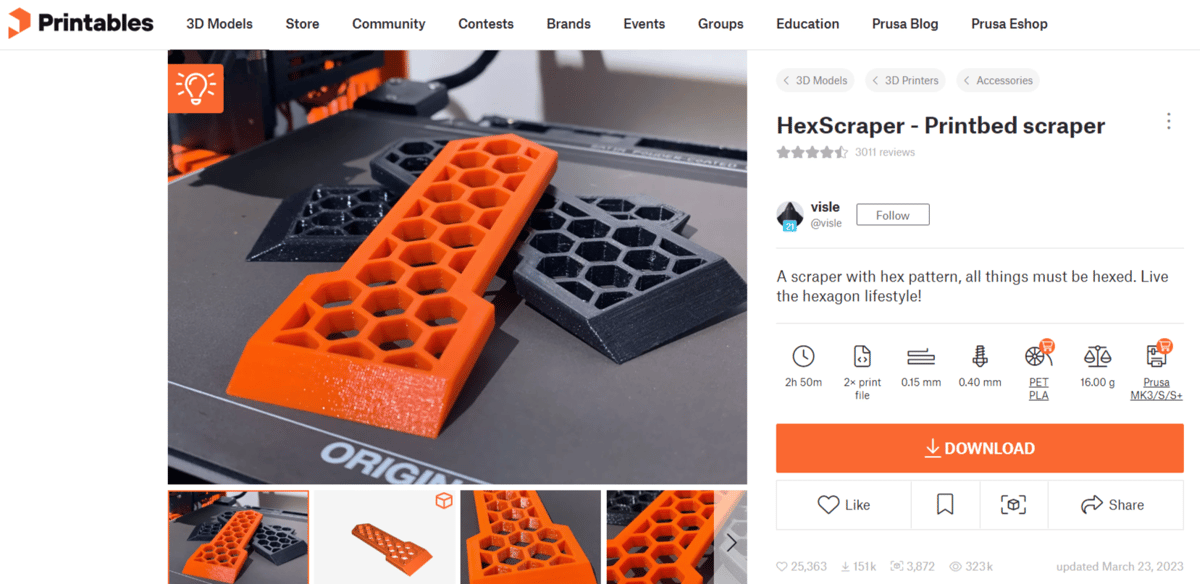
When Prusa Research rebranded its repository in early 2022, it caused a few waves. Just as Thingiverse began as the branded repository for MakerBot, the iconic printers by Joseph Prusa needed a place to host files for their ecosystem. That place was PrusaPrinters.
However, as apparent in the stories of other repositories associated with 3D printer manufacturers, closed systems limit growth. By early 2022, a new identity was needed to bring the rest of the world to the site, and rebranding to Printables was a quick way to open up the audience.
Well-known for quality printers, Prusa has a similarly polished repository. Categorization and filtering are particularly well done, so that finding your desired model is fast and easy. Searching can also be done by printer type, material, nozzle diameter, print time, and even filament use amount. The search even supports differentiation for resin 3D printing.
The popular site also leans heavily on education to bring 3D printing into the hands of more and more users. Registration for the education section is completely free for schools, universities, and other educational institutions. With it, special discounts are available on the Prusa Eshop, and users can access Prusa Academy online courses.
Printables continues to evolve with plans for more changes and additions in the near future. For example, a reward system for creators was implemented late in 2021. They run regular contests and there’s also a marketplace with paid models available.
- Registration required: Yes
- Number of free models: Over 690,000
GrabCAD
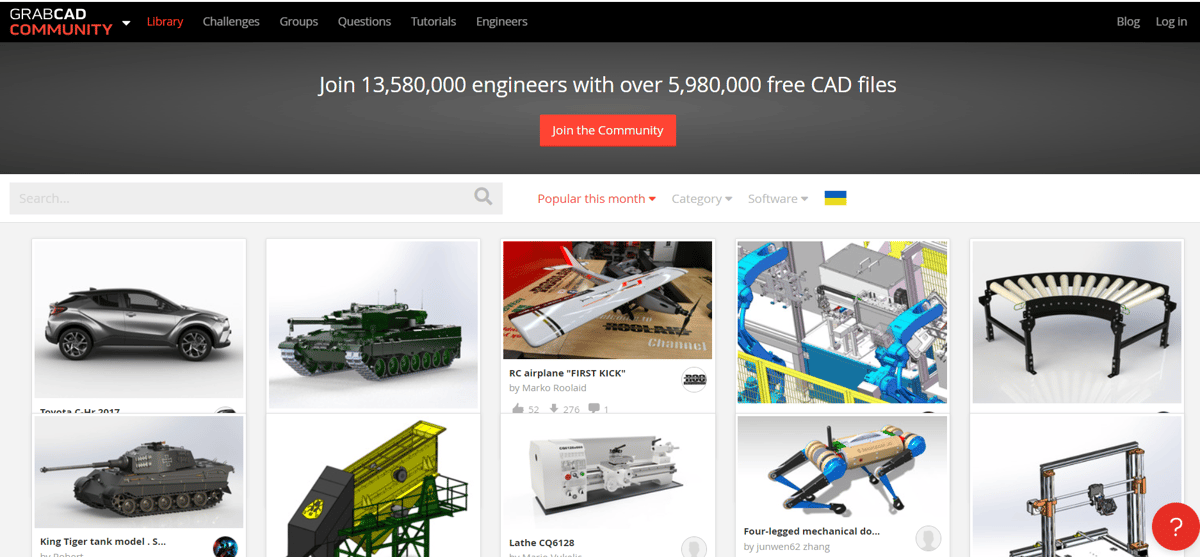
GrabCAD was created in 2009 by Hardi Meybaum and Indrek Narusk to create a space where CAD professionals could collaborate on engineering and architectural projects. Over time, the community expanded into other areas, including 3D printing and the Internet of Things (IoT). In 2014, it was purchased by Stratasys, one of the leaders in 3D printing. This acquisition allowed Stratasys to expand its product and service offering by integrating the GrabCAD Workbench platform into its 3D printing platform.
GrabCAD is proud that it has a community of over 13,580,000 engineers with millions of free CAD files. However, when searching, only about 10,000 free files appear in STL format. To see all of the results, you’ll need to select the STL filter and then change the “Popular this month” filter to “Popular all time”.
Since GrabCAD is aimed at engineers and architects, there is a large variety of technical and structural models. However, it still has some fun print-in-place models available, like Wall-E. By applying the STL and 3D printing filters, it’s possible to find several pages of models and more elaborate projects, such as the Turbo Jet Motor 550.
- Registration required: Yes
- Number of free models: Over 5,900,000
Cults
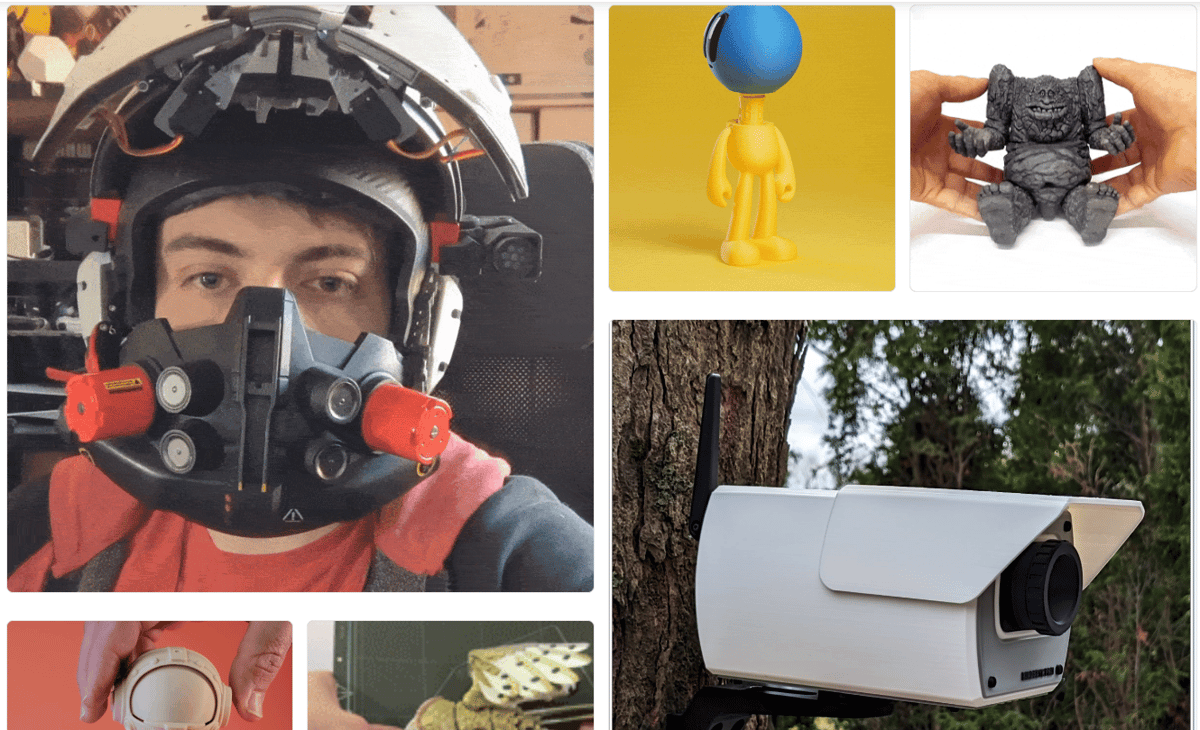
The French site Cults may have an unusual name (backward, it spells St. Luc, the patron saint of artists and sculptors), but it’s also unique in that it was the first independent 3D file repository when it launched in 2014. Since then, it has grown to become one of the most popular repositories for 3D printing.
Although Cults is a repository that allows designers to share or sell their designs, it isn’t obvious at first glance that free files are part of the mix. But with a simple filtering option, the free files come to the forefront.
With more than six million users and over 1.6 million designs, the repository has amassed a significant amount of printable files. As with most repositories, it offers categorization as well as good filtering tools to narrow your searches. Categories run the gamut of usual suspects – such as art, architecture, and gadgets – to the more interesting ones, such as Naughties and Ideas. They also frequently host contests, run a monthly featured set of STLs, and even have a random option to help you find a new design.
Their rivalry with Thingiverse is quite apparent on the site: They prominently offer to “automatically import all your 3D models shared on Thingiverse to Cults.” You can’t really get more obvious than that.
- Registration required: Yes
- Number of free models: Not specified, but well over 200,000
MakerWorld
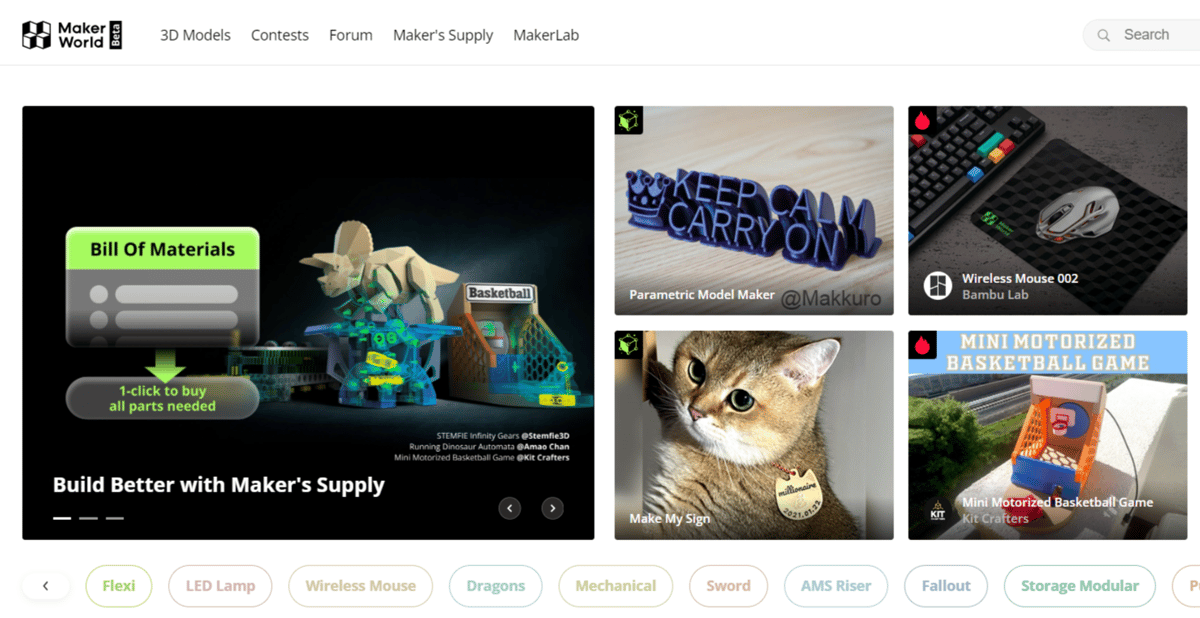
Recently launched by Bambu Lab, MakerWorld is a user-friendly 3D model platform that’s directly integrated with Bambu Lab printers. This means that you can print models from the site at the click of a button (as long as you’re using a Bambu Lab 3D printer).
MakerWorld offers similar features to Printables and Thingiverse, but some unique aspects set it apart from the crowd. For example, the points system rewards users who are regularly active with Bambu Lab gift cards, filament, replacement parts for your printer, and more. You can earn points by completing your personal profile, and by uploading models and print profiles for other users to enjoy.
In addition, there are regular contests and a dedicated forum where you can connect with other members of the community. Multi-color prints are readily available, and the collection of models is growing rapidly. However, as MakerWorld is currently in a beta version, changes to the site and reward system are expected to come.
- Registration required: Yes
- Number of free models: Not specified, but well over 100,000
MyMiniFactory
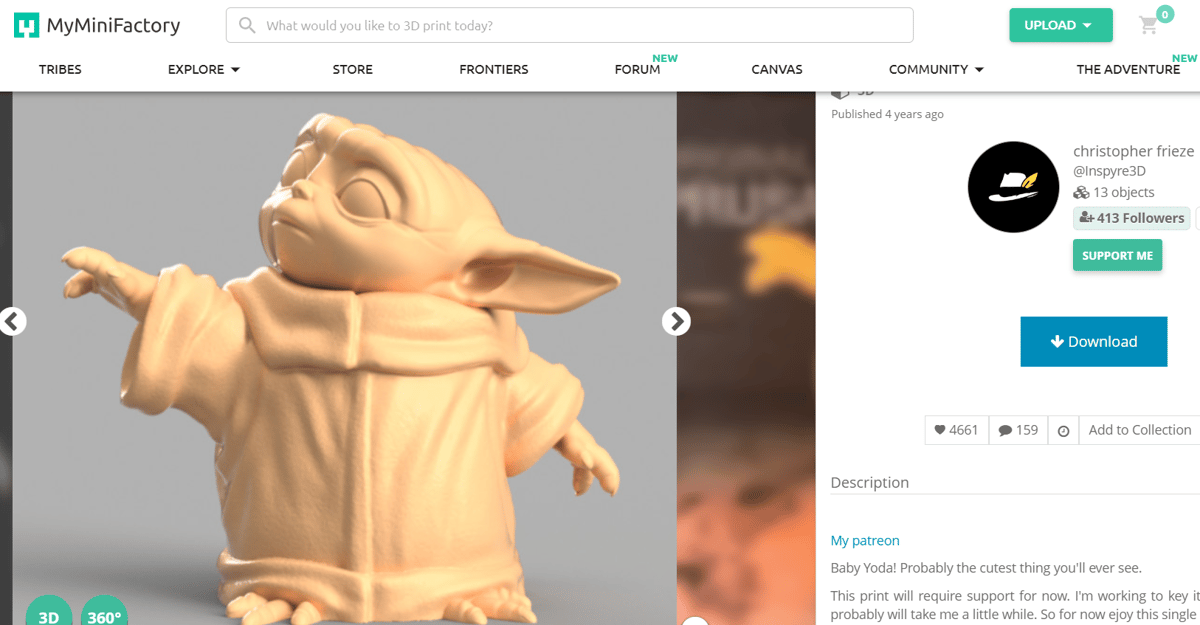
MyMiniFactory, unlike Thingiverse, is all about the marketplace. While there are a significant number of free files on the site, the focus is on purchasable designs. Based in the UK and launched by iMakr, the site is extremely popular with gamers and is the go-to for high-quality tabletop figures and models.
While the site has been around since 2013, it really moved into its current marketplace model around 2018. Since then, it has grown into a particularly engaged community. In fact, one of the unique aspects of the repository is that it’s community-curated. Files are tested and checked before being made available for public download. Additionally, the site hosts competitions and even includes a premium subscription service that gives discounts in the marketplace as well as several other benefits.
Like Thingiverse, the success of this site is due to its growing community. The enthusiasm for the site’s offerings is responsible for the explosive growth. In the last year or so, the site has added new features such as PDF hosting and Tribes. Tribes is a system for creators to give their supporters access to exclusive content via a paid tier-based subscription model. If you’re a designer looking to monetize your work, this might be the site for you.
- Registration required: Not for downloads, but it is required for all other features
- Number of free models: Over 143,000
Pinshape
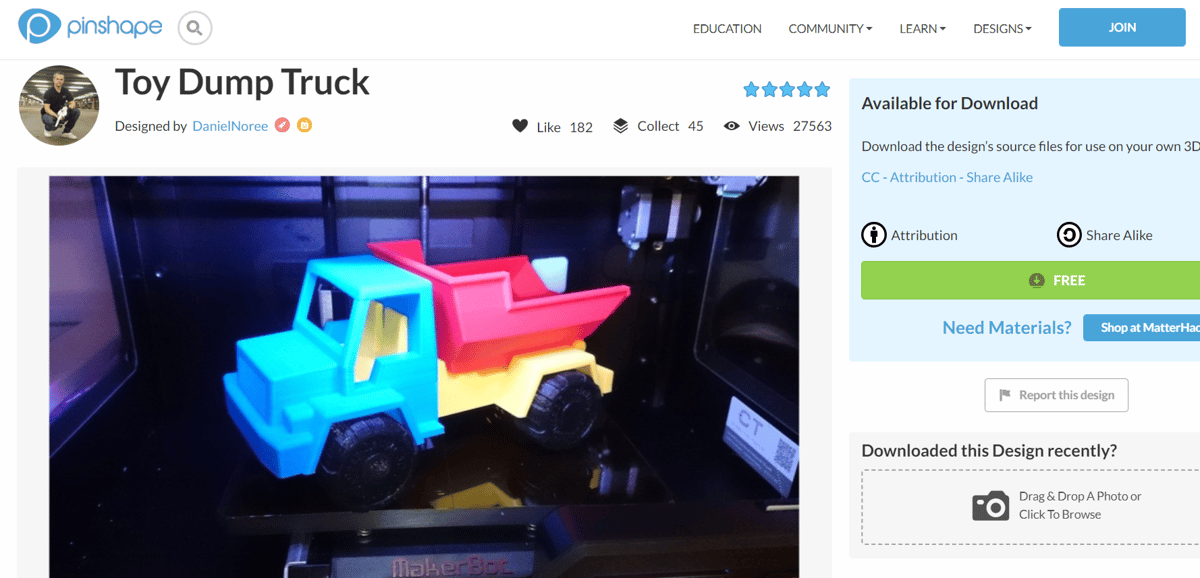
Pinshape began as an independent website when launched in 2013. Formlabs acquired it in 2016 to act as their companion marketplace, much as MakerBot does with Thingiverse.
Unlike Thingiverse, free and paid files are available on Pinshape. The site provides a filter to easily separate them. There are typical features such as community prints, likes, and collections, but unlike Thingiverse, there are no remixes. Designs are organized into categories and tagged with various identifiers for licensing and printer type.
Pinshape’s standout feature is its educational hub with guides covering software and hardware projects, post-processing, 3D printing materials, and more. Similar to Thingiverse, they even provide lesson plans for teachers looking to introduce students to 3D printing.
Unfortunately, the site maintenance and updating have been inconsistent over the past few years. Several links throughout the site don’t work, and the educational materials they provide have become somewhat dated.
- Registration required: Yes
- Number of free models: Over 36,000
CGTrader
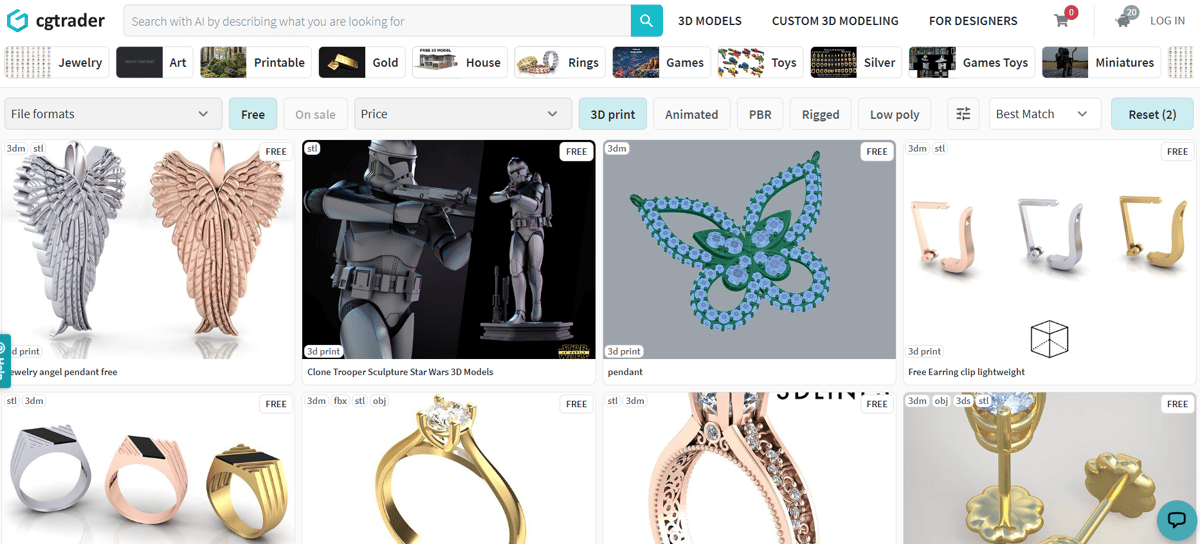
CGTrader is an online marketplace offering free and paid 3D models. Founded in 2011 by designer Marius Kalytis, it has become one of the largest commercial marketplaces. The community has been expanding since its creation and currently has over 9 million users and nearly 2 million 3D models, of which over 18,000 are free.
This site has a royalty system where sellers can earn 70% to 80% of income from their sales. This makes it a place for professionals looking to make some extra cash selling 3D models or who want to take on freelance projects. CGTrader is mainly focused on professionals who use VR/AR and CG, but STL files and other formats are available.
The website itself has a clean interface with clear images. Several filters help you narrow down your search to find exactly what you’re looking for. In addition, if you find a paid model that you’re interested in, you can contact the seller and negotiate the price. Either way, it’s worth checking out CGTrader if you still haven’t found the model you’re looking for.
- Registration required: Yes
- Number of free models: Over 18,000
Free3D

Created in 2012, Free3D is, as the name suggests, dedicated to free 3D models across a wide variety of categories. This platform has grown to become a community of over 2.7 million registered users with more than 10,000 free 3D models. More than 7,300 of them are available in STL and OBJ format. In 2020, the platform was bought by TurboSquid, which has the distinction of being the largest 3D model marketplace.
Although the acquisition took place over two years ago, the site remains as it was before, maintaining a simple interface with thumbnail images and different categories to help sort through search results. What makes this a worthy alternative is the large amount of 3D models and the specific filter that helps you quickly find 3D printable models. Like other sites on this list, Free3D also has a marketplace side with premium 3D models for commercial use at relatively reasonable prices.
It’s important to note that not all Free3D models are high quality, and, in some cases, adjustments may be necessary.
- Registration required: No
- Number of free models: Over 10,000
Zortrax Library
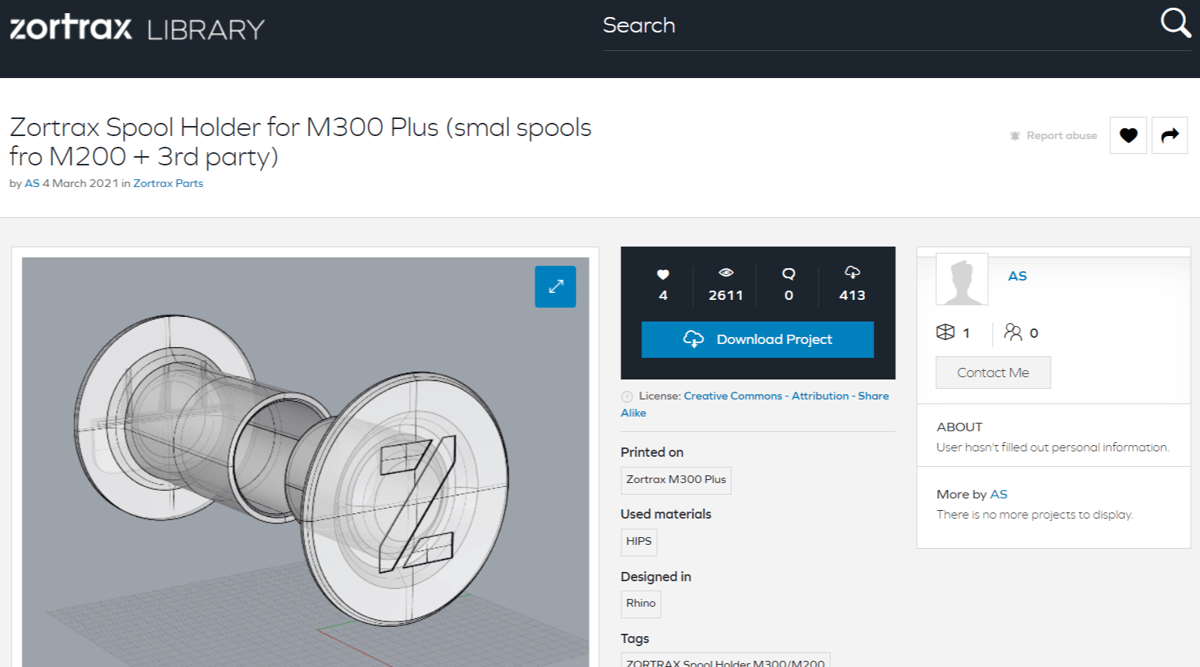
The Zortrax Library was originally launched as an integrated part of the company’s Z-Suite software and was only accessible to users of Zortrax 3D printers. Much like Thingiverse, the company eventually split the library from the software and made it openly available online. That means anyone can now browse and download the free STL files and print them on any brand of machine.
While the site doesn’t have as many files as others, they’re neatly arranged into a dozen categories, including a section just for Zortrax parts. As a company, Zortrax focuses on providing precision printing primarily to business professionals. Because of this, the contents of the repository tend to lean in that direction. However, as more and more users have found the site, the available content has diversified.
- Registration required: Yes
- Number of free models: Not specified
Thangs
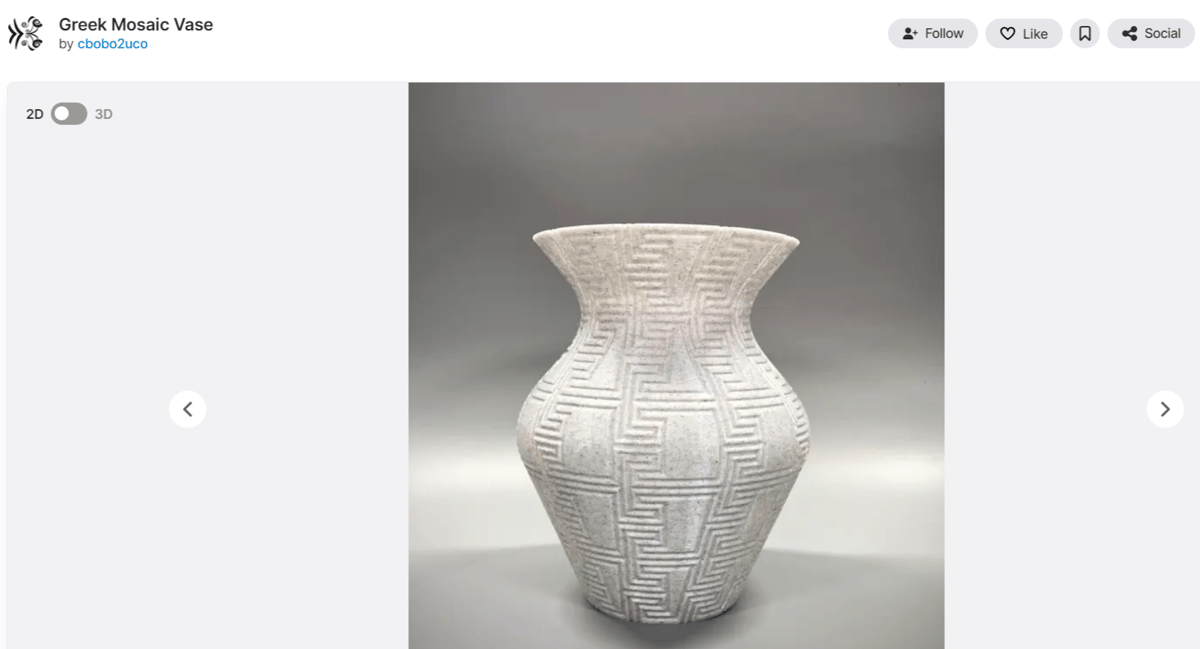
One of the most popular alternatives to Thingiverse is Thangs. However, the site isn’t so much a repository as it is a search engine for 3D files. Amazingly, the site has amassed over 19 million files from around the web. While this may sound very impressive, only a portion of these are actually hosted on the site. Many models link to “external sites” such as Thingiverse.
While the site is relatively young (it only launched in August 2020), it has rapidly grown a community. Much like software designers use GitHub to organize, collaborate, and revise, Thangs provides a similar resource for designers, engineers, architects, and scientists working on 3D objects. Designers can upload their creations and use collaboration tools to annotate, compare, and track their work.
Like Thingiverse, the files on Thangs are available for free. Offsite models are mostly free but do connect to some paid files. The site also has some great filtering tools, allowing you to sort free and paid models as well as by file type and even which external site you’d like to search.
Thangs underwent a refresh and now has a cleaner UI. It also boasts features such as augmented reality for Android or Apple phones to visualize a model in the real world. They’ve even launched a 3D file backup service called Thangs Sync that lets designers store revisions in the cloud.
- Registration required: Yes (also depends on external vs. internal files)
- Number of free models: Not specified
Honorable Mentions: Smaller Repositories
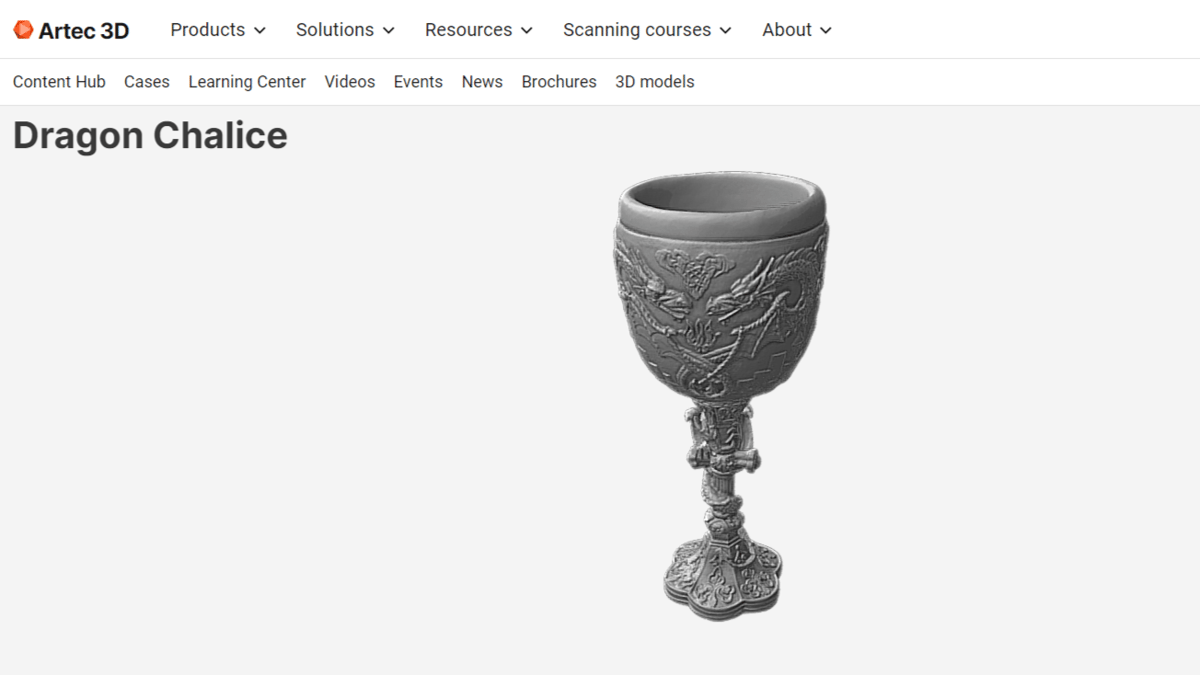
Considering the growing popularity of 3D printing, it’s not surprising that several new, smaller repositories are making a name for themselves. Here are some other options worth checking out for 3D models:
Artec3D
Artec3D is best known as a developer and manufacturer of 3D scanning hardware and software. However, hidden away on their site is an entirely free library of files! Just like Thingiverse back in its early days, Artec3D provides these files to showcase the company’s technology. Lucky for us, it also makes for a great repository.
Most files are high quality and on the upper end of what would be considered a printable file. The categories are divided between industrial design and manufacturing, medical, science and education, and art and design. You can even sort by the type of scanner used to create the file. The majority of the files are available in multiple formats and are under a Creative Commons license.
- Registration required: No
- Number of free models: Over 170
Threeding
Founded in 2013 by a group of friends in Bulgaria, Threeding began with the idea of sharing 3D files to print at home, but soon realized there was potential for growth. The following year, the platform started to allow users to buy and sell models, which made the platform even more popular with enthusiasts, modelers, and designers. Threeding is also known for its work in digitizing and preserving cultural heritage. In 2016, they partnered with Artec to digitize and preserve a collection of historical artifacts at Bulgaria’s National Museum of Military History. They created a series of 3D models of the artifacts, which are now available online.
- Registration required: Yes
- Number of free models: More than 1,700 free STL files
Repables
Launched in 2014 by MatterHackers, a company specializing in 3D printing, Repables began with the aim of growing the 3D printing community and sharing free models. The platform is focused on providing high-quality, print-ready templates, with the assurance that they’ve been tested and validated before becoming available for download.
- Registration required: No
- Number of free models: Not specified
License: The text of "The Best Thingiverse Alternatives" by All3DP is licensed under a Creative Commons Attribution 4.0 International License.

